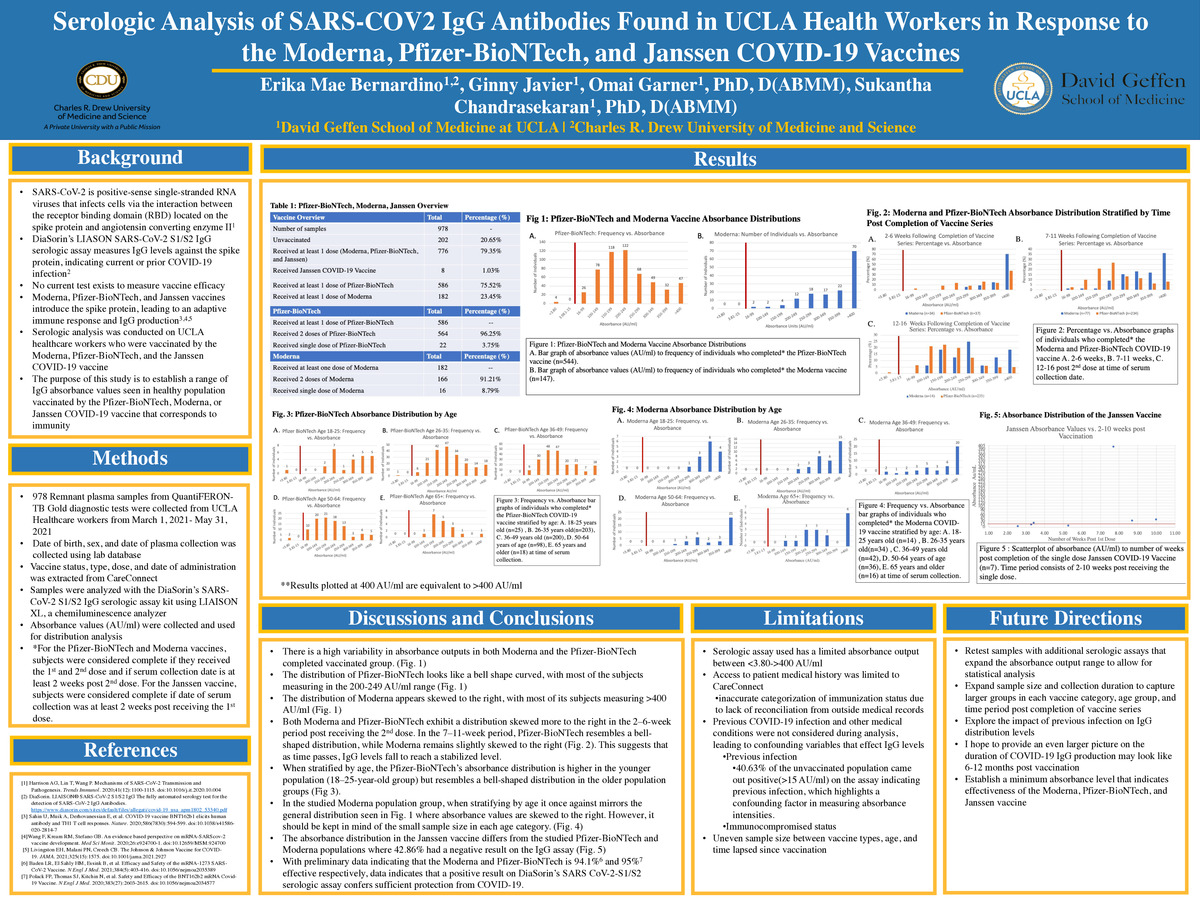-
Author
Erika Mae Bernardino -
PI
Sukantha Chandrasekaran PhD, D(ABMM), Dr. Omai Garner PhD, D(ABMM)
-
Co-Author
Ginny Javier, Omai Garner PhD, D(ABMM); Sukantha Chandrasekaran PhD, D(ABMM)
-
Title
Serologic Analysis of SARS-COV2 IgG Antibodies found in UCLA Health Employees in Response to Moderna, Pfizer-BioNTech, and Janssen COVID-19 Vaccines
-
Program
STTP
-
Other Program (if not listed above)
-
Abstract
Abstract
On March 11 2019, the World Health Organization (WHO) has declared COVID-19 as a global pandemic, and two days later, the United States followed suit, declaring a National Emergency1. With a strong emphasis to fight the SARS-CoV-2 virus through vaccinations, there has been a rapid push in the development and distribution of COVID-19 vaccines worldwide. At the time of writing, the Food & Drug Administration (FDA) has issued emergency use authorization (EUA) to three vaccines in the United States: Pfizer-BioNTech COVID-19 Vaccine (December 2020), Moderna COVID-19 Vaccine (December 2020), and Janssen COVID-19 Vaccine (February 2020)2. However, little is understood about the COVID-19 Immunoglobulin G (IgG) response in the vaccinated population. Additionally, there is still limited information to determine at what antibody level leads to immunity, or how long this immunity should last, raising the question for the need of vaccine boosters. This research project explores the IgG absorbance distribution in vaccinated UCLA healthcare workers using DiaSorin’s LIASON SARS-CoV-2 S1/S2 IgG serology test.
Learning Objectives
- Analyze the IgG serologic response of the Pfizer-BioNTech, Moderna, and Janssen vaccines in UCLA health care workers 2-19 weeks post vaccination
Background
SARS-CoV-2 is positive-sense single-stranded RNA viruses that infects cells via the interaction between the receptor binding domain (RBD) located on the spike protein (S Protein) and the host’s Angiotensin Converting Enzyme II (ACEII)2. Therefore, current vaccine technology targets this interaction by creating neutralizing antibodies targeting the spike protein to prevent the SARS-CoV-2 virus from entering the host cell. Both the Pfizer-BioNTech (BNT162b1) and Moderna (mRNA-1723) vaccine utilizes lipid nanoparticle formulated mRNA vaccine technology, by encoding for the receptor-binding domain of the SARS-CoV-2 spike protein3,4. Similarly, the Janssen vaccine introduces the spike protein to the host through an adenovirus rather than through mRNA5. Although it is generally accepted that the vaccine provides protection from high mortality and morbidity from the virus, little is understood about the Immunoglobulin G (IgG) response in the vaccinated population nor how long the IgG response should last. To measure IgG antibodies, DiaSorin’s LIASON SARS-CoV-2 S1/S2 IgG serologic assay was used to measure vaccine efficacy. Clinically, this assay detects if a subject had an adaptive response to COVID-19, indicating a current or prior infection to COVID-196. In this study, we used this assay to measure COVID-19 IgG production in response to the vaccine to explore what the distribution of IgG antibodies are in vaccinated populations, and if this distribution can confer immunity.
Methods
A total of 978 remnant samples from QuantiFERON-TB Gold diagnostic tests were collected from UCLA Health care workers between March 01, 2021 and May 31, 2021. Samples were stored in -20C until day of serologic analysis. Remnant QuantiFERON-TB Gold tubes provided patient name, sex, date of birth, and medical record number, collection date. Vaccination status, vaccine type, vaccine dose, and dates of vaccine administration were extracted from CareConnect. Samples were analyzed utilizing the Liaison XL chemiluminescence analyzer with DiaSorin’s SARS-CoV-2 S1/S2 IgG serologic assay. This assay is used to detect IgG antibodies against S1/S2 antigens of SARS-CoV-2, and has an output range of <3.80- <400 AU/ml. Absorbance values (AU/ml) were collected and used for distribution analysis.
Results
Frequency vs. Absorbance (AU/ml) graphs were created for individuals who completed the COVID-19 vaccines and grouped by vaccine type (Fig. 1). Data was further stratified and graphed by number of weeks post receiving the 2nd dose: 2-6 weeks, 7-10 weeks, 10-14 weeks, 15-19 weeks post receiving the 2nd dose (Fig. 2), and by age: 18-25, 26-35, 36-49, 50-64, and 65+ (Fig. 3,4). A scatterplot of absorbance (AU/ml) to number of weeks post completion of the single dose Janssen COVID-19 Vaccine (Fig. 5) was made. In the studied unvaccinated population, 40.63% tested positive (>15 AU/ml) on the assay indicating previous infection.
Conclusion
There is no current reference range availble pertaining to spike protein IgG levels in response to vaccination. Based on this study, the distribution of absorbance intensities in both the studied Pfizer-BioNTech and Moderna populations were highly variable. However of the fully vaccinated groups, 99.3% of the Pfizer-BioNTech group and 100% of the Moderna group tested postive on DiaSorin’s SARS-CoV-2 S1/S2 IgG serologic assay. With preliminary data indicating that the Moderna and Pfizer-BioNTech is 94.1%7 and 95%8 effective respectively, this data suggests that a positive result on DiaSorin’s SARS CoV-2-S1/S2 serologic assay indicates sufficient protection from COVID-19.
References
- Koirala A, Joo YJ, Khatami A, Chiu C, Britton PN. Vaccines for COVID-19: The current state of play. Paediatr Respir Rev. 2020;35:43-49. doi:10.1016/j.prrv.2020.06.010
- Harrison AG, Lin T, Wang P. Mechanisms of SARS-CoV-2 Transmission and Pathogenesis. Trends Immunol. 2020;41(12):1100-1115. doi:10.1016/j.it.2020.10.004
- Sahin U, Muik A, Derhovanessian E, et al. COVID-19 vaccine BNT162b1 elicits human antibody and TH1 T cell responses. Nature. 2020;586(7830):594-599. doi:10.1038/s41586-020-2814-7
- Wang F, Kream RM, Stefano GB. An evidence based perspective on mRNA-SARScov-2 vaccine development. Med Sci Monit. 2020;26:e924700-1. doi:10.12659/MSM.924700
- Livingston EH, Malani PN, Creech CB. The Johnson & Johnson Vaccine for COVID-19. JAMA. 2021;325(15):1575. doi:10.1001/jama.2021.2927
- DiaSorin. LIAISON® SARS-CoV-2 S1/S2 IgG The fully automated serology test for the detection of SARS-CoV-2 IgG Antibodies. https://www.diasorin.com/sites/default/files/allegati/covid-19_usa_apm1802_53340.pdf
- Baden LR, El Sahly HM, Essink B, et al. Efficacy and Safety of the mRNA-1273 SARS- CoV-2 Vaccine. N Engl J Med. 2021;384(5):403-416. doi:10.1056/nejmoa2035389
- [7] Polack FP, Thomas SJ, Kitchin N, et al. Safety and Efficacy of the BNT162b2 mRNA Covid-19 Vaccine. N Engl J Med. 2020;383(27):2603-2615. doi:10.1056/nejmoa2034577
-
PDF
-
Zoom
https://uclahs.zoom.us/j/94117873864?pwd=QlNSakNjNVVXcHdyVGpFTlpXODl5UT09

